10 Best Herbal Juices For Burns

Herbal juices can be a natural and soothing remedy for minor burns, offering a gentler alternative to chemical treatments.
Ingredients like aloe vera, calendula, and chamomile are commonly used in herbal juices due to their anti-inflammatory and healing properties. These juices help reduce redness, swelling, and pain while promoting skin regeneration. To use them effectively, it is important to apply the juice directly to the affected area and keep the burn clean and covered.
However, it is advisable to consult a healthcare professional for severe burns or if symptoms persist, as herbal remedies may not be sufficient for all cases.
FREE Herb Drying Checklist
How to make sure every batch retains maximum flavor, color, and aroma without the risk of mold or over-drying. Eliminate guesswork and trial-and-error, making herb drying faster, easier, and more efficient every time.
Table of Contents
1. Aloe barbadensis

Aloe barbadensis, commonly known as aloe vera, is a popular herbal plant used for its soothing and healing properties, particularly for treating burns.
Its gel contains anti-inflammatory compounds and antioxidants that help reduce pain, redness, and swelling associated with minor burns. Aloe vera juice, derived from the inner gel of the plant, is often applied topically to promote skin regeneration and prevent infection. It is especially effective for first-degree burns, such as sunburns or minor scalds, due to its cooling and hydrating effects.
However, it is important to ensure that the aloe juice is pure and free from harmful additives to avoid irritation or adverse reactions.
2. Calendula officinalis

Calendula officinalis, commonly known as pot marigold, is a popular herbal remedy used to treat burns due to its anti-inflammatory and antiseptic properties.
The herbal juice extracted from its flowers contains bioactive compounds like flavonoids and triterpenes, which help soothe skin irritation and promote healing. When applied topically, calendula juice can reduce redness, swelling, and pain associated with minor burns and sunburns. It is often used in natural first-aid preparations and can be combined with other soothing herbs like aloe vera for enhanced benefits.
However, it is important to consult a healthcare professional before using calendula juice on severe burns or for extended periods.
3. Hypericum perforatum

Hypericum perforatum, commonly known as St. John's Wort, has been traditionally used for its potential healing properties, including the treatment of burns.
Herbal juices made from the plant contain compounds such as hypericin and flavonoids, which may help reduce inflammation and promote skin repair. When applied topically, these juices can soothe minor burns and aid in the regeneration of damaged skin tissue. However, it is important to note that while some studies suggest its efficacy, more research is needed to confirm its safety and effectiveness for burn treatment.
As with any herbal remedy, it is advisable to consult a healthcare professional before use, especially for severe burns.
4. Urtica dioica

Urtica dioica, commonly known as stinging nettle, has been traditionally used for its anti-inflammatory and soothing properties, making it a potential ingredient in herbal juices for treating burns.
When prepared properly, stinging nettle juice can help reduce pain, inflammation, and scarring associated with minor burns due to its high content of antioxidants and minerals. However, it is important to note that the raw juice of Urtica dioica can cause skin irritation due to the presence of histamine and other irritants, so it should be diluted or processed carefully. Some herbal formulations combine stinging nettle with other calming herbs like aloe vera or chamomile to enhance its therapeutic effects on burns.
While it may offer natural relief, it is advisable to consult a healthcare professional before using stinging nettle juice for burns, especially for severe cases.
5. Centella asiatica

Centella asiatica, also known as gotu kola, is a traditional herbal plant that has been used for centuries in Ayurvedic and Chinese medicine for its healing properties.
Centella asiatica herbal juices are believed to promote skin regeneration and reduce inflammation, making them a popular natural remedy for burns. The active compounds in these juices, such as asiatic acid and madecassonic acid, help stimulate collagen production and enhance skin repair. When applied topically, these juices can soothe minor burns, reduce pain, and accelerate the healing process.
However, it is important to consult a healthcare professional before using centella asiatica on severe burns or if you have any underlying medical conditions.
6. Echinacea purpurea

Echinacea purpurea, commonly known as purple coneflower, is a traditional herbal remedy that has been explored for its potential benefits in treating burns.
While it is more widely recognized for its immune-boosting properties, some studies suggest that echinacea may possess anti-inflammatory and antimicrobial qualities that could aid in the healing process of minor burns. When used in the form of herbal juices, echinacea may help reduce redness, swelling, and infection risk in burn wounds. However, it is important to note that echinacea should not replace conventional medical treatments for severe burns and should be used under the guidance of a healthcare professional.
Overall, while echinacea herbal juices show promise as a complementary therapy, further research is needed to fully understand their efficacy and safety in burn care.
7. Lavandula angustifolia

Lavandula angustifolia, commonly known as English lavender, has been traditionally used for its soothing and healing properties, and its essential oil and herbal juices are often utilized to treat burns.
The anti-inflammatory and antimicrobial properties of lavender help reduce pain, swelling, and the risk of infection in minor burns. When diluted properly, lavender herbal juice can be applied topically to the affected area to promote faster healing and skin regeneration. It is important to note that while lavender may provide relief, it should not replace professional medical treatment for severe burns.
Overall, lavender herbal juices offer a natural and complementary approach to managing the symptoms of minor burns.
8. Rosa canina

Rosa canina, commonly known as rosehip, is a traditional herbal remedy that has been used for centuries to support skin health and healing.
Its juice, rich in vitamin C, antioxidants, and essential fatty acids, can help reduce inflammation and promote the regeneration of damaged skin tissue. When applied topically, rosa canina juice may alleviate symptoms of minor burns by soothing the skin and accelerating the healing process. It is often recommended as a natural alternative to commercial burn treatments due to its gentle and nourishing properties.
However, it is important to consult a healthcare professional before using rosa canina juice on severe burns to ensure safe and effective treatment.
9. Zingiber officinale

Zingiber officinale, commonly known as ginger, has been traditionally used for its anti-inflammatory and analgesic properties, making it a popular ingredient in herbal juices for treating burns.
These juices are believed to help reduce pain and inflammation associated with minor burns by promoting circulation and soothing the affected skin. The active compounds in ginger, such as gingerol and shogaol, may contribute to its healing properties by inhibiting inflammatory responses. However, while some studies suggest potential benefits, more research is needed to confirm its effectiveness for burn treatment.
It is important to consult a healthcare professional before using ginger-based remedies, especially for severe burns.
10. Sutherlandia frutescens

Sutherlandia frutescens, also known as the "cancer bush," is a traditional South African herb that has been used for centuries in herbal medicine.
While it is commonly associated with cancer support, some people use Sutherlandia frutescens herbal juice for burns, believing it may have soothing and healing properties. However, there is limited scientific evidence to support its effectiveness in treating burns, and it should not replace conventional medical treatments. The juice is typically prepared by steeping the dried plant in water or alcohol, and it is sometimes applied topically to the affected area.
It is important to consult a healthcare professional before using Sutherlandia frutescens for burns, as it may interact with other medications or have side effects.